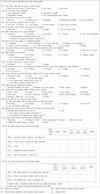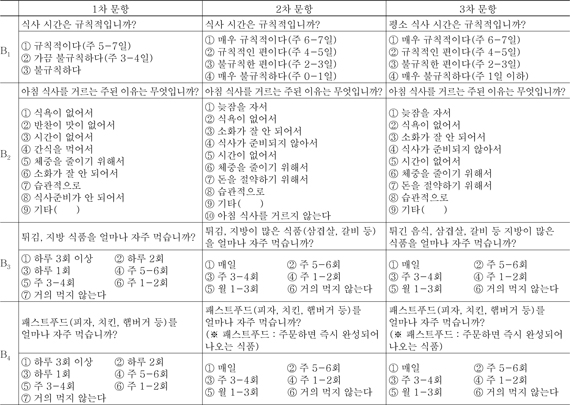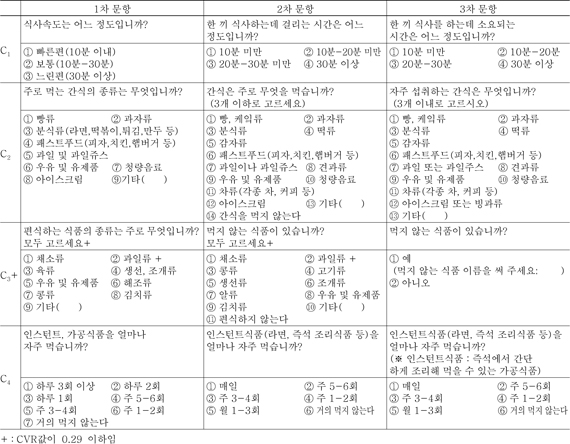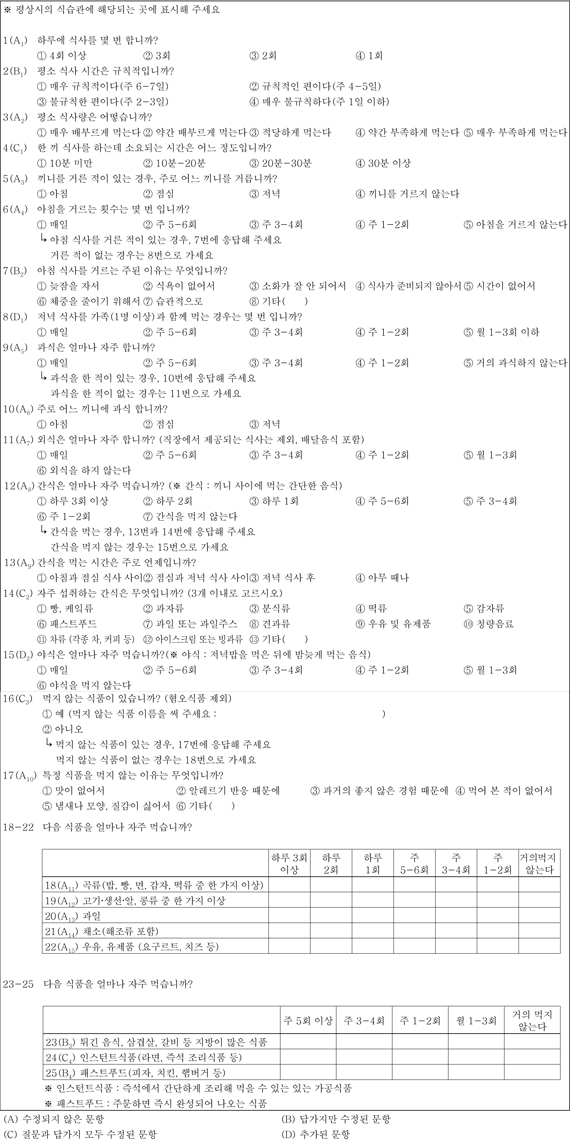Abstract
Objectives
The purposes of the study were to develop a questionnaire for dietary habit survey for Korean adults, and unify the terms related to dietary habits.
Methods
The Delphi method by 43 professionals on dietary habit research was applied to unify the terms.
Results
With regard to results on terms related to dietary habit, the respondents recorded the highest percentage (90.7%) of selecting the term "dietary habits" and also the highest percentage (76.7%) of choosing "dietary habits" for English. The biggest percentage of the respondents chose "individual dietary behaviors repeatedly formed and habitualized under the social, cultural, and psychological influence in the group" as the concept of dietary habits. The Delphi survey for the development of a questionnaire resulted in the first questionnaire of 31 items, the second one of 27 items, and the third one of 25 items. The validity of questionnaire items was tested with content validity ratios (CVR). The items whose CVR value was 0.29 or lower were eliminated or revised, because the minimum CVR value needed to test validity was 0.29. To test the reliability of questionnaire items, test-retest method was performed in 163 adults. According to the Kappa coefficient in the range of 0.314-0.716, all of the 25 items were in the reliability scope. A survey was taken with 702 adults to finally revise and supplement the third questionnaire whose validity and reliability were tested.
Figures and Tables
Table 2
Items whose answers were revised based on the first and second Delphi survey

1) Detailed Korean questions : See Supplement 2
Table 3
Items whose question and answers were revised based on the first and second Delphi survey

1) Detailed Korean questions : See Supplement 3
2) They will be removed since their CVR is under the cut-off value (0.29).
Table 4
Added items based on the second Delphi survey

1) Detailed Korean questions : See Supplement 4
Table 5
Kappa coefficient of each item of the questionnaire

1) Detailed questions : See Table 6, Supplement 5
References
1. Chang NS, Lee YS, Lim HS, Ahn HS. Nutrition through the life cycle. Paju: Kyomunsa;p. 309–312.
2. Choi JH, Lee ES, Lee YJ, Lee HS, Chang HJ, Lee KE, Yi NY, Ahn Y, Kwak TK. Development of food safety and nutrition education contents for the elderly-by focus group interview and delphi technique. Korean J Community Nutr. 2012; 17(2):167–181.
3. Cohen J. A coefficient of agreement for nominal scales. Educ Psychol Meas. 1960; 20(1):37–46.
4. Han BR, Bae HS. Development and evaluation of the semi-quantitative food frequency questionnaire to assess folate Intake in women of child-bearing age. Korean J Community Nutr. 2012; 17(2):156–166.
5. Im SJ. Dietary habit and vegetables Intake of certain adults women with irregular meal time. Keimyng University;2011. 42–54. Dissertation.
6. Ji SK, Kim HS, Choi HM. A study on development and validation of food frequency questionnaire for estimating energy intake of women in child-bearing age. Korean J Community Nutr. 2008; 13(1):111–124.
7. Jo JS, Lee KS, Kim KN. Research trend of nutrition through analysis of articles published in 'Korean Journal of Community Nutrition'. Korean J Community Nutr. 2011; 16(2):278–293.
8. Kim HH, Shin EK, Lee HJ, Lee NH, Chun BY, Ahn MY, Lee YK. Analysis by delphi survey of a performance evaluation index for a salt reduction project. Korean J Nutr. 2009; 42(5):486–495.
9. Kim WY, Cho MS, Lee HS. Development and validation of mini dietary assessment index for Koreans. Korean J Nutr. 2003; 36(1):83–92.
10. Kim KN, Hyun T, Lee JW. Development of a simple screening test for identifying Korean elderly at risk of undernutrition. Korean J Community Nutr. 2000; 5(3):475–483.
11. Kim KN, Kim AJ, Park ES, Woo MK, Lee BK, Hyun TS. Content analysis of the questionnaires used in dietary surveys. Korean J Community Nutr. 2000; 5(4):697–708.
12. Kim MK, Yun YM, Kim YO. Developing dish-based food frequency questionnaire for the epidemiology study of hypertension among Korean. Korean J Community Nutr. 2008; 13(5):701–712.
13. Kim MY, Suh I, Nam CM, Yoon JY, Shim JS, Oh KW. The development and evaluation of a simple semi-quantitative food frequency questionnaire using the contribution of specific foods to absolute intake and between-person variation of nutrient consumption. Korean J Nutr. 2002; 35(2):250–262.
14. Kim WY, Yang EJ. A study on development and validation of food frequency questionnaire for Koreans. Korean J Nutr. 1998; 31(2):220–230.
15. Korea Institute for Special Education. The dictionary of special education. Seoul: Hawoo;2009. p. 175–186.
16. Korean National Statistics Office. The statistics of chronic disease. 2010. cited January 13, 2014. available from http://www.kostat.go.kr.
17. Kwon DH. Education evaluation. Seoul: Hakjisa;2008. p. 17–38.
18. Lawshe CH. A quantitative approach to content validity. Pers Psychol. 1975; 28(4):563–575.
19. Lee HJ, Lee HS, Ha MJ, Kye SH, Kim CI, Lee CW, Yoon JS. The development and evaluation of a simple semi-quantitative food frequency questionnaire to assess the dietary intake of adults in large cities. Korean J Community Nutr. 1997; 2(3):349–365.
20. Lee HJ, Park SJ, Kim JH, Kim CI, Chang KJ, Yim KS, Kim KW, Choi HM. Development and validation of a computerized semi-quantitative food frequency questionnaire program for evaluating the nutritional status of the korean elderly. Korean J Community Nutr. 2002; 7(2):277–285.
21. Lee HY, Chung L, Yang I. Conceptualizing and prospecting for home meal replacement (HMR) in Korea by delphi technique. Korean J Nutr. 2005; 38(3):251–258.
22. Lee JS. Delphi method. Paju: Kyoyookbook;2001. p. 7–49.
23. Lee JY, Ahn HS, Kim YS. Development and validation of a short food frequency questionnaire for estimating calcium intake. Korean J Health Promot Dis Prev. 2000; 1(1):8–17.
24. Lee YM, Lee MS, Lee MJ, Kim JH, Chung HY. Nutrition through the life cycle. Paju: Yangseowon;2013. p. 283–287.
25. Lim Y, Oh SY. Development of a semi-quantitative food frequency questionnaire for pre-school children in Korea. Korean J Community Nutr. 2002; 7(1):58–66.
26. Paik HY, Ryu JY, Choi JS, Ahn YJ, Moon HK, Park YS, Lee HK, Kim YI. Development and validation of food frequency questionnaire for dietary assessment of Korea adults in rural area. Korean J Nutr. 1995; 28(9):914–922.
27. Park DS. Education evaluation. Paju: Kyoyookbook;2007. p. 8–23.
28. Park JA, Yoon JS. A screening tool for identifying high-risk pregnant women of fe deficiency anemia : process I. Korean J Community Nutr. 2001; 6(5):734–743.
29. Park JA, Yoon JS. A screening tool for identifying high-risk pregnant women of fe deficiency anemia : process II. Korean J Community Nutr. 2003; 8(2):160–170.
30. Park YS, Han JL, Lee JW, Cho HS, Koo JO, Kim JH, Yoon JS. The development of a simple evaluation questionnaire for screening the overweight-type dietary pattern in 30 to 49 year old adults. Korean J Community Nutr. 2002; 7(4):495–505.
31. Park YS, Lee JW. Development of a simple evaluation questionnaire for screening the dietary patterns of overweight young adults. Korean J Community Nutr. 2002; 7(5):675–685.
32. Ryu SH, Yoon JH. The use of likert scale in community nutrition research: analysis of the articles published in Korean Journal of Community Nutrition. Korean J Community Nutr. 2009; 14(5):600–607.
33. Seong TJ. Validity and reliability. Seoul: Hakjisa;2002. p. 36–181.
34. Shim JS, Oh KW, Suh I, Kim MY, Sohn CY, Lee EJ, Nam CM. Development of a semi-quantitative food frequency questionnaire for pre-school children in Korea. Korean J Community Nutr. 2002; 7(4):484–494.
35. Son SM, Huh GY, Lee HS. Development and evaluation of validity of dish frequency questionnaire (DFQ) and short DFQ using na index for estimation of habitual sodium intake. Korean J Community Nutr. 2005; 10(5):677–692.
36. Son SM, Park YS, Lim WJ, Kim SB, Jeong YS. Development and evaluation of validity of short dish frequency questionnaire (DFQ) for estimation of habitual sodium intake for Korean adults. Korean J Community Nutr. 2007; 12(6):838–853.
37. Won HS, Kim WY. Development and validation of a semi-quantitative food frequency questionnaire to evaluate nutritional status of Korean elder. Korean J Nutr. 2000; 33(3):314–323.
38. Yim KS, Lee TY, Park HS. The development and validation of a food frequency questionnaire to assess diets of Korean adolescents. Korean J Community Nutr. 2003; 8(2):149–159.
39. Yon M, Hyun T. Development of an eating habit checklist for screening elementary school children at high risk of energy overintake. Korean J Nutr. 2008; 41(5):414–427.
40. Yon M, Hyun T. Development of an eating habit checklist for screening elementary school children at risk of inadequate micronutrient intake. Korean J Nutr. 2009; 42(1):38–47.




 PDF
PDF ePub
ePub Citation
Citation Print
Print











 XML Download
XML Download